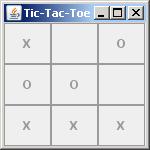Tic-Tac-Toe
From BP Wiki
Contents
A behavioral program for the game of Tic-Tac-Toe
- Download the example from
Game Description
Two players, X and O, alternately mark squares on a 3X3 grid whose squares are identified by <row,column> pairs: <0,0>, <0,1>, ...,<2,2>. The winner is the player who manages to form a full horizontal, vertical or diagonal line with three of his/her marks. If the entire grid becomes marked but no player has formed a line, the result is a draw.
In our example, player X should be played by a human user, and player O is played by the application. Each move (marking of a square by a player) is represented by an event, X_<row,col> or O_<row,col>. Three additional events, XWin, OWin, and draw$, represent the respective victories and a draw.
A play of the game may be described as a sequence of events. E.g., the sequence
X_<0,0>, O_<1,1>, X_<2,1>, O_<0,2>, X_<2,0>, O_<1,0>, X_<2,2>, XWin describes a play in which X wins, and whose final configuration is:28.
b-Threads
Rules of the game
- SquareTaken: block further marking of a square already marked by X or O.
- EnforceTurns: alternately block O moves while waiting for X moves, and vice versa (we assume that X always plays first).
- DetectXWin: wait for placement of three X marks in a line and request XWin.
- DetectOWin: wait for placement of three O marks in a line and request OWin.
- DetectDraw: wait for nine moves and request draw event.
